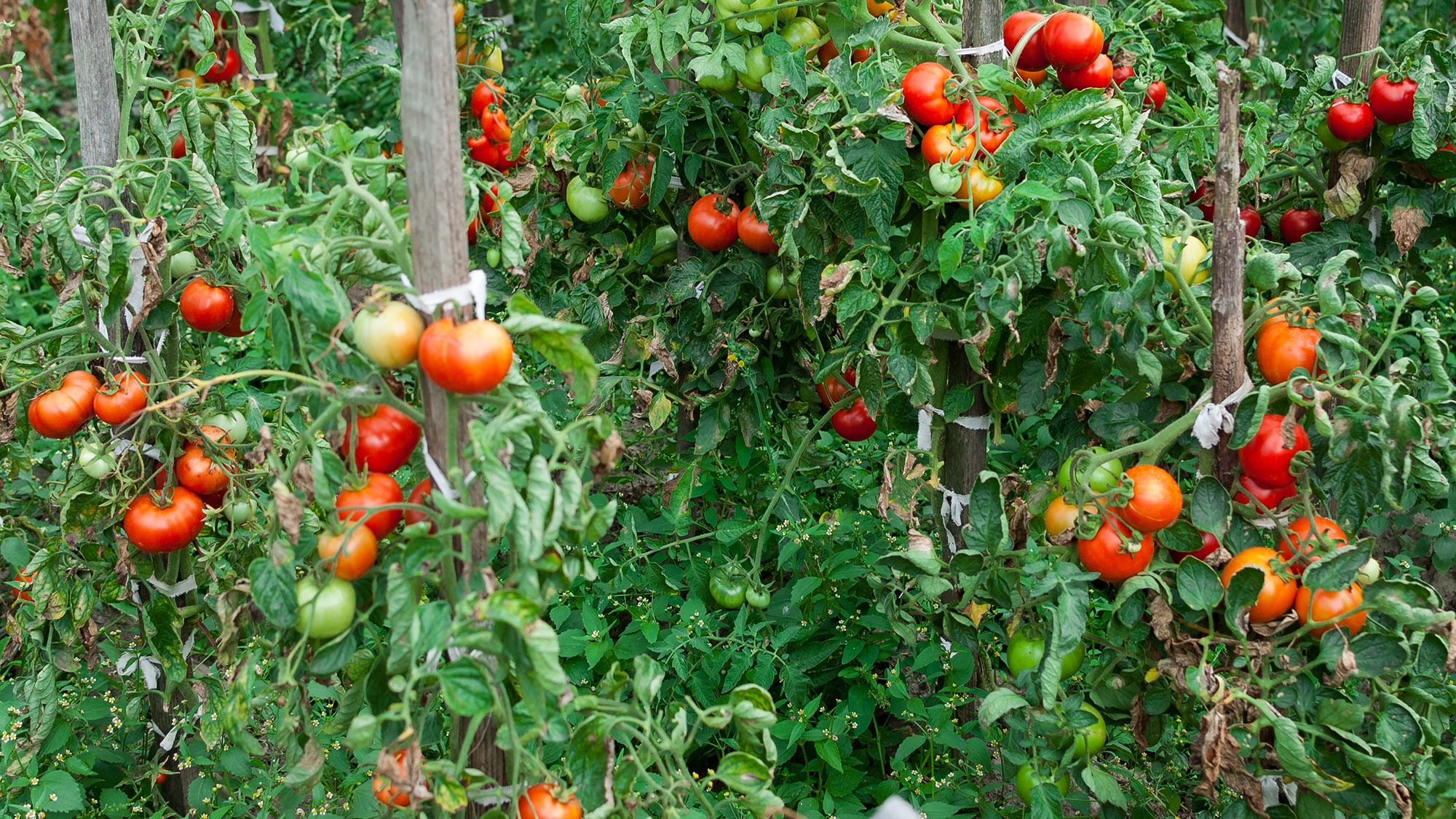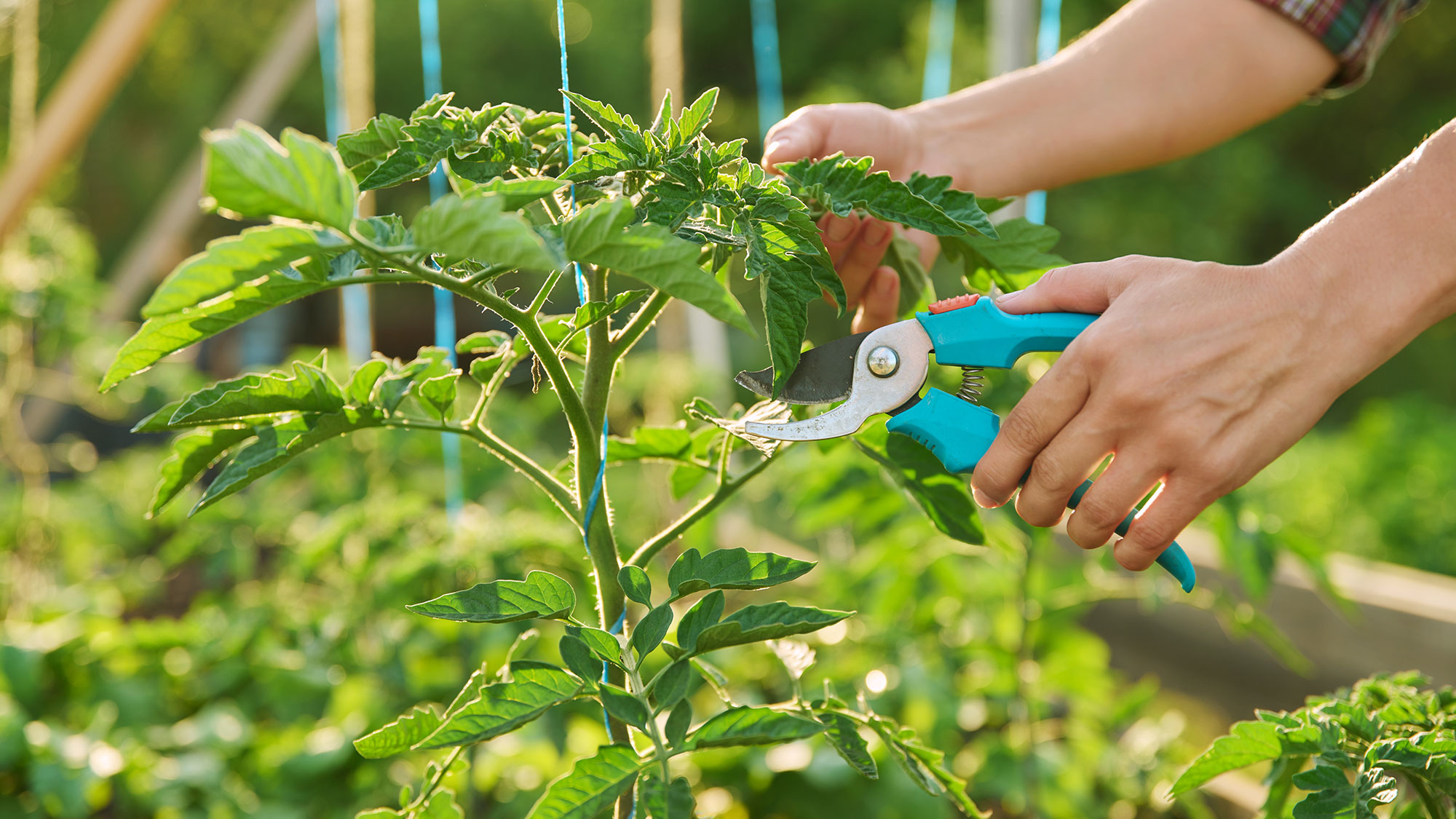7 pruning mistakes that could damage your tomato plant
It’s all about striking the right balance

Many plants require regular pruning to keep them healthy and improve their vigor and appearance. Pruning involves cutting away young growth to keep a plant manageable and at a healthy size. It can also help reduce the risk of fungal disease by cutting away dense leaves that limit airflow around the plants. Removing unnecessary stems can also divert energy to where you want it — helping to invigorate flowers or fruits, rather than excess foliage. The result will enable you to get more fruit from a tomato plant and grow juicy tomatoes.
Tomato plants are a particularly good contender for pruning as the indeterminate varieties grow as leggy vines, which can sprawl if left unchecked. When a plant grows so freely, it can take up much more space than intended and may not produce the volume of fruit you hope for. Rather than concentrating on the fruits, the energy is being used to increase the size and length of the plant.
Knowing how to prune tomato plants, you can control this growth and direct it towards high-quality fruiting rather than an overabundance of leaves. However, if you prune the wrong way, your efforts will be ineffective at best and could end up hurting the plant and restricting its ability to fruit.
To ensure you are pruning your tomatoes correctly, avoid these 7 common mistakes.
1. Confusing determinate and indeterminate tomato plants

Some gardeners have probably told you that they don’t prune their tomato plants, and you’re now wondering if you really need to prune yours. It all depends on whether you grow determinate or indeterminate tomatoes.
Determinate
Determinate varieties have a preset height that they grow towards and don’t grow beyond that, meaning there is no need to prune the plants to keep them in check. Instead, pruning off young growth will simply inhibit its ability to produce fruit.
Since they fruit in one go and then are finished for the season, you could be seriously inhibiting your harvest if you cut off any stems and suckers. While you may want to cut away any underhanging foliage to create airflow, there is no need to do any further pruning.
Indeterminate
Indeterminate varieties are different and do require pruning. Indeterminate means that these plants have no set height or size, so they will continue to grow tall and sprawl if you don’t monitor and shape their growth.
Sign up to get the BEST of Tom's Guide direct to your inbox.
Get instant access to breaking news, the hottest reviews, great deals and helpful tips.
This type of tomato plant will also fruit in waves over the summer, so it’s important to keep an eye on the newer sprouts and rein them in as necessary. This will encourage more energy towards tomato fruit on the established vines. If you leave these plants unchecked the way you would a determinate variety, you might end up with a huge plant with minimal fruit — which is rarely anyone’s preference.
2. Pruning plants when wet

Water is a crucial component for happy plants, but it can also bring about a lot of damage if not handled correctly. While all plants need water to survive, excess water around the roots and on leaves can become host to different fungal diseases that can harm your plants. These diseases can be impossible to treat, so it’s all about preventing the infection in the first place.
One of the easiest ways to expose your plants to fungal disease is to prune them when wet — this creates openings in the plant’s exterior that disease can travel into and spread. Since fungal disease often lives in water, if pruning shears are wet, disease can often be transferred from plant to plant while pruning. One infected plant can quickly become a garden full of infected plants, simply from one pruning session. If you must prune when the tomato plants are wet, make sure to dry off your pruning shears after each cut.
Felco (F6) bypass pruners: was $65 now $53 @ Amazon
These high-quality, Swiss-made pruners have a hardened steel blade capable of cutting 0.8 inches of material. The smooth, red handle is ergonomically designed to provide comfort while cutting. These pruners are ideal for medium-sized hands.
3. Over-pruning

Once you start pruning, it’s easy to get carried away! While it’s useful to remove young suckers that might take away valuable nutrients from the rest of your plant, you probably don’t want to cut away all of them. It’s generally recommended to keep between one and four stems on an indeterminate tomato plant to strike a balance between an abundant harvest and a high-quality one.
While you won’t kill the plant by cutting away all but one main stem, you will limit the amount of fruit that your plant can bear — which may not be what you want. This could also produce a strange-looking result that is unbalanced or top-heavy.
Another risk of over-pruning is that you cut away too much foliage. While the leaves themselves won’t be part of your harvest and take away some of the plant’s energy to grow, they do have a useful function — they protect the fruit from harsh sunlight. If you cut off too much foliage, you risk exposing the young fruit to full summer sun, which can burn and scald the tomatoes. This will hurt your harvest before it has a chance to fully mature. Instead, you want to leave sufficient leaves in place for them to create pockets of shade in which your tomatoes can flourish.
4. Under-pruning

As with everything, it’s all about balance — you also don’t want to under-prune your tomato plants. If you are too cautious with your efforts, you won’t reap the benefits of pruning and may simply open yourself up to the risks, like spreading disease.
One clear risk area is the foliage that grows on the lowest part of the stalk, which will often touch the ground if not pruned away. These leaves can increase the chance of disease traveling from the soil surface to the plant and also inhibit airflow, so their presence is almost entirely negative. Leaving these leaves in place will make your tomato plant vulnerable and may simply look messy.
You also want to make sure you are catching and removing those suckers that will continue to sprout through the summer. Suckers get their name from their sucking of valuable nutrients from the rest of the plant, so don’t be afraid to tackle them early. If left, they will absorb a lot of the plant’s energy and may not mature into fruiting stems by the end of the season. If they do manage to produce fruit, these will likely be smaller and lower quality than the more established stems.
5. Pruning from above, not below

So, you now understand the importance of pruning and removing suckers and you’re ready to get to work. You look at your plant, identify a sucker midway up the main stem and make your cut. You continue this action, cutting away at the upper half of the plant, and then remember the dangers of over-pruning. You stop your work — leaving the excess suckers and foliage in place around the base of the plant. This is a huge mistake.
Leaves at the bottom of the plant stem are the most likely source of fungal disease and, therefore, the most important to remove. They also don’t create any useful shade for the fruits as they are too low down, so they should be removed. Suckers that emerge on the lower part of the plant, say on the first two feet of the main stem, also risk drooping and coming into contact with the ground. They will clog up that area and reduce the airflow, while also being further away from the sun, which inhibits their ripening. Even if you want to keep some suckers and let them grow, the ones at the bottom should not be left in place.
6. Using dirty or dull tools

This isn’t about aesthetics; dull and dirty tools can cause real damage to your plant, especially when pruning. This is because you’re creating active wounds in the surface of the plant and using dirty tools can promote the spread of disease. There could be fungal disease in the hardened soil on your blade edge or some other unwanted contaminant that is easily transferred to the tomato plant during the pruning process. By taking the time to wipe down your tools — ideally in between each plant’s pruning session — you reduce this exposure risk.
Dull tools can also cause damage, although of the more material kind. A dull tool will not cut as effectively and may end up creating larger, messier serrations than a sharp tool would. These wounds will require more energy to heal and take longer to do so, leaving the plant vulnerable to infection for longer. If your shears can’t cut cleanly through a piece of paper, they shouldn’t be used on your tomato plant. Sharpen your blades or buy new ones, rather than harming your garden.
Top tip
To stop the spread of disease when pruning, it’s important to maintain your best pruning shears. Knowing how to sharpen pruning shears, to give a clean cut, and how to clean pruning shears, to prevent passing on disease, are two top maintenance tips.
7. Pruning at the wrong time

Timing is everything. Start pruning too early, before the tomato plant can establish its roots, and you risk putting it under stress. It may be unable to continue maturing if it feels like it’s under attack so young, or its growth may be stunted in the long term. Be sure to give your plant a few weeks to settle in before you begin wielding your pruning shears.
However, if you wait too long to prune, several unwanted stems may be too established to easily remove. These plants may already be overgrown and hard to tame back into a manageable shape, which will impact the plant’s long-term productivity.
It’s not just about when you start; it’s also about the time of day that you prune. Midday should be avoided, as the sun is at its highest and most powerful, and therefore, the heat of the sun could damage your plant when it’s at its most vulnerable. Pruning in the early morning or evening is generally safer for the tomato plant.
Finally, don’t leave the plant unpruned when nearing the end of the season. You may think there’s no value to pruning when you only have a few weeks left before the first frost, but this would be a mistake. The end of the season is exactly when you want your plant to direct all its energy into maturing its last few fruits, instead of towards new growth. By topping off the plant, you signal to the tomato plant that it needs to set the rest of its fruit rather than grow new ones — this is key to getting a bountiful harvest at summer’s end.
More from Tom's Guide
Madeleine Streets is a writer and content manager based in New York City. She covers an eclectic mix of lifestyle, technology, finance and health and has been published in Tom's Guide, Women's Wear Daily, SELF, Observer, Footwear News and others. Originally from London, Madeleine has a penchant for tea, baking and moody weather. When she’s not writing, you can find her exploring the city’s bookstores, hunting down new restaurants, fostering cats and cheering on Arsenal FC.


